Foxglove, scientifically known as Digitalis purpurea, is a striking and iconic flowering plant known for its towering spires of tubular blossoms. Native to Europe and parts of Asia, Digitalis belongs to the family Plantaginaceae. While Foxglove is considered a short-lived perennial, it will naturally self-seed to continue propagation. While its toxicity requires careful handling, the right care and respect for its unique qualities can bring a touch of elegance and drama to any garden setting.
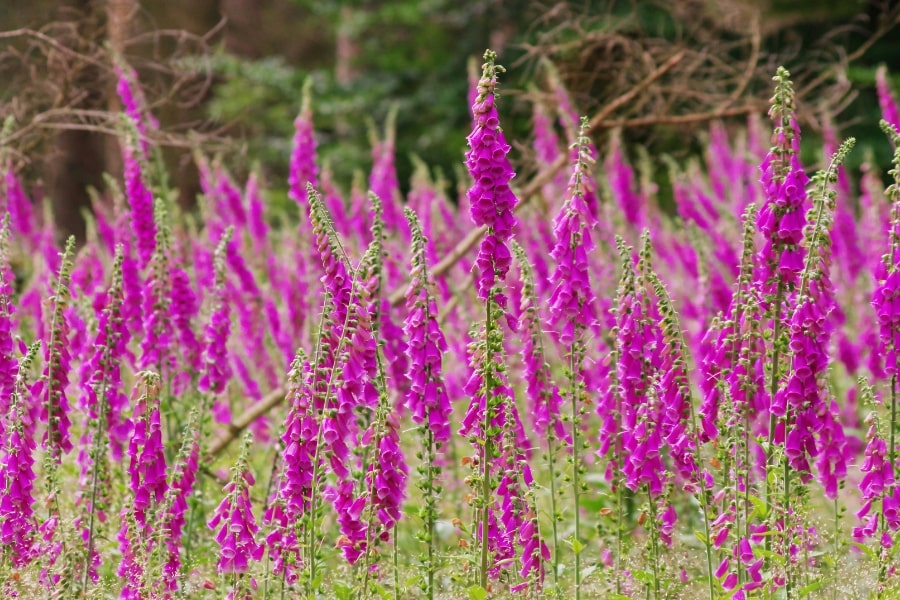
Our Selection of Foxglove
At Martin Garden Center, we carry Foxglove in 4″ pots beginning in the spring. Our vendors grow the Dalmation variety because it is more heat tolerant. However, growing Foxglove in the afternoon sun may be wise in the Upstate.
We continue to see Foxglove periodically, but not consistently, throughout the year. So we are only sure that it will be stocked in the early spring, circa early to mid-March. Because of its rapid growth rate, any leftover 4″ Foxglove may be potted up to 1-gallon containers in the summer.
We are growing the following varieties in 2025:
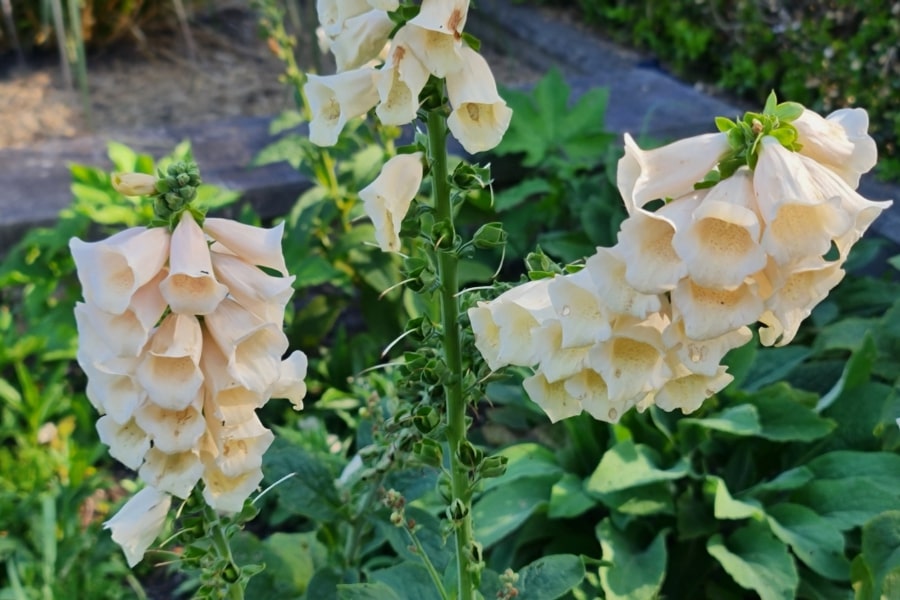
Growing and Caring For Foxglove
- Foxglove plants prefer well-drained, acidic to neutral soil enriched with organic matter.
- While they tolerate some sunlight, especially in cooler climates, they generally prefer dappled sunlight or partial shade locations. In the SC Upstate, planting Foxglove in an area where they receive morning sun but afternoon shade is best.
- Provide adequate spacing between Foxglove plants to allow for proper air circulation and prevent overcrowding. This helps prevent diseases and ensures that each plant has sufficient access to light and nutrients.
- Regular watering, especially during dry spells, is crucial for the initial establishment of Foxglove. Once established, they demonstrate good drought tolerance, but consistent moisture contributes to healthier and more robust growth.
- Deadheading promotes continuous blooming and prevents the plant from expending energy on seed production, encouraging the growth of additional flowers.
- Once the flowering period is over, trimming back the spent flower stalks helps redirect the plant’s energy and encourages a neater appearance.
- Foxglove is generally resistant to most pests and diseases, however, slugs and snails can be attracted to the foliage. Applying organic slug control methods, such as beer traps or copper tape around the base of the plant, can help mitigate this issue.
Toxicity
Foxglove contains compounds called cardiac glycosides, which can affect the heart. All parts of Foxglove, including leaves, flowers, and seeds, contain these toxic compounds, and ingesting even small amounts can lead to severe health issues. Caution is advised, especially in households with pets or small children.
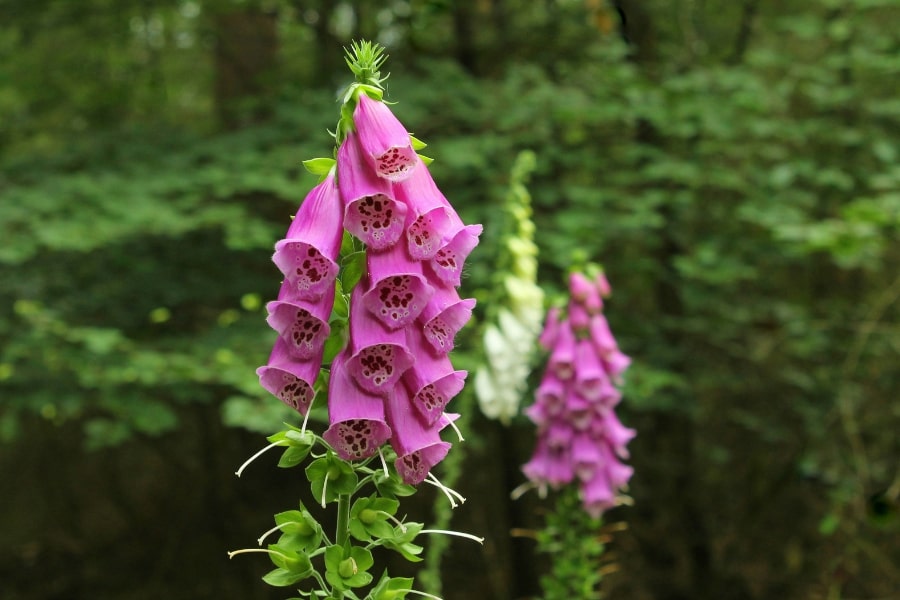
Leaves and Flowers
Foxglove leaves are basal and form a rosette at the plant’s base. They are large, lance-shaped, and possess a slightly fuzzy texture. The leaves are often a lush green color, providing an attractive backdrop to the tall flower spikes.
One of the most captivating features of Foxglove is its distinctive tubular flowers that form along tall, erect spikes. These flowers, which can be various shades of pink, purple, white, or yellow, are arranged in a classic, spire-like inflorescence. The tubular shape of the blooms makes them particularly attractive to pollinators like bees, hummingbirds, and butterflies, which play a vital role in the plant’s reproductive cycle.
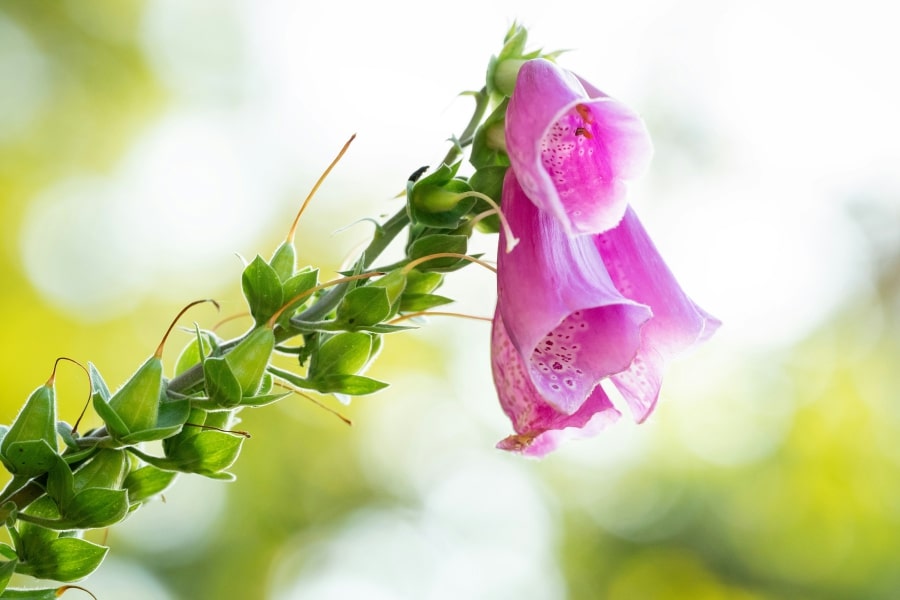
Uses in Gardening and Landscaping
Foxglove’s commanding presence and striking blooms make it a favored choice for gardening and landscaping. The plant works well as a focal point in cottage gardens, woodland gardens, or mixed perennial borders. Planted in groups, Foxglove creates a visually arresting display, especially when the tall spires rise above lower-growing plants.
Additionally, Foxglove’s preference for partial shade makes it suitable for shaded areas beneath trees or along the north side of buildings. Its tolerance for different soil types contributes to its versatility in garden design. Foxglove can also be used as a temporary screening plant, providing height and interest in areas where other plants have yet to establish themselves.
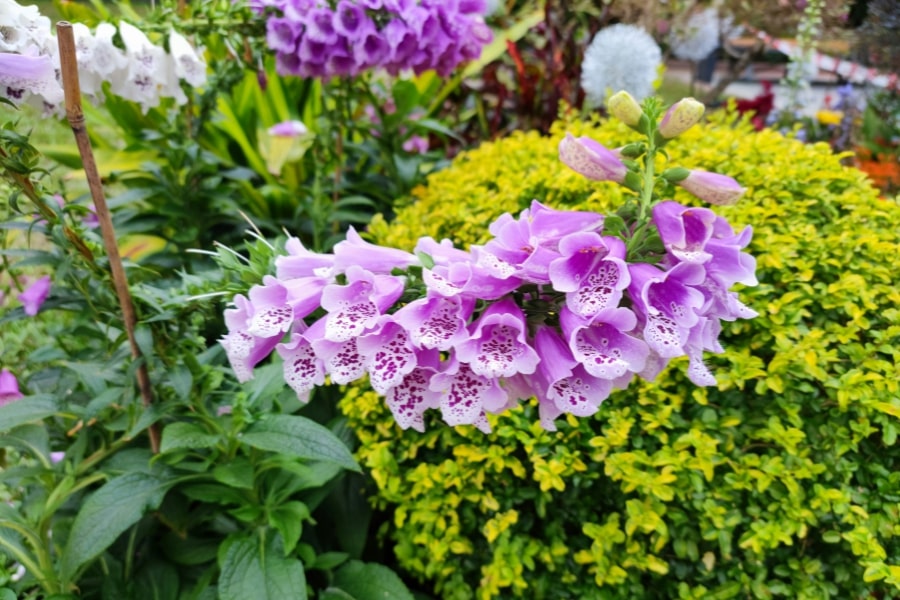
Frequently Asked Questions
Is Foxglove Poisonous?
Foxglove (Digitalis) is highly toxic to humans, pets, and livestock. The plant contains cardiac glycosides, which can affect the heart and other vital organs. All parts of the foxglove plant, including the leaves, flowers, and seeds, are toxic. Ingesting even small amounts of Foxglove can lead to symptoms such as nausea, vomiting, diarrhea, abdominal pain, confusion, and, in extreme cases, heart arrhythmias or even death.
Is Foxglove a Perennial?
Foxglove is typically considered a biennial or short-lived perennial plant. In its first year, Foxglove produces a low rosette of leaves, and in the second year, it sends up tall flower spikes with tubular blossoms. After flowering and setting seeds, the plant usually dies back.
However, Foxglove is known to self-seed prolifically, and new plants may emerge from the dropped seeds, creating a continuous cycle. In favorable climates and with proper care, foxglove plants can persist for over two years. Some gardeners also extend the life of Foxglove by allowing it to reseed and perpetuate itself in the garden.
How To Grow Foxglove From Seed?
- Selecting Seeds: Choose high-quality foxglove seeds from a reputable supplier or collect seeds from mature foxglove plants in late summer or early fall. Ensure that the seeds are fresh and viable for optimal germination.
- Timing: Depending on your climate, foxglove seeds can be sown either in early spring or late summer to early fall. Sowing in late summer allows the seeds to experience a period of cold stratification, which can improve germination rates.
- Preparing the Soil: Foxgloves prefer moist, well-draining soil with partial shade to full sun. Before sowing seeds, prepare the soil by loosening it to a depth of about 6 inches (15 cm) and incorporating organic matter such as compost to improve fertility.
- Sowing Seeds: Scatter the foxglove seeds over the prepared soil surface, lightly pressing them into the soil with your fingertips. Avoid covering the seeds with soil, as they require light for germination.
- Watering: Gently water the soil after sowing to ensure it remains evenly moist but not soggy. Using a fine mist or a watering can with a rose attachment can help prevent the seeds from dislodging.
- Germination: Foxglove seeds typically germinate within 14 to 21 days when kept in moist soil at temperatures around 65 to 70°F (18 to 21°C). During this time, continue to monitor soil moisture and provide supplemental watering as needed.
- Thinning Seedlings: Once the seedlings have developed their first true leaves, thin them to about 12 to 18 inches (30 to 45 cm) apart to allow sufficient space for growth. Choose the healthiest seedlings to retain and gently remove any excess seedlings to prevent overcrowding.
- Caring for Seedlings: Keep the young foxglove seedlings consistently moist but not waterlogged. Protect from strong winds and extreme temperatures until they become established. Apply a balanced fertilizer once a month to promote healthy growth.
- Transplanting: Transplant seedlings to their final growing location in the garden when they have developed several sets of leaves and are sturdy enough to withstand transplant shock. Ensure the new location provides adequate sunlight and well-draining soil.
- Enjoying Blooms: With proper care, foxglove seedlings will mature and produce their characteristic tall spikes of flowers in their second year. Once established, foxgloves may self-seed and return year after year, adding beauty and charm to your garden landscape.
When Does Foxglove Bloom?
Foxglove typically blooms in late spring to early summer, though the exact timing can vary based on climate and growing conditions. Deadheading spent flowers can encourage a longer blooming period.
